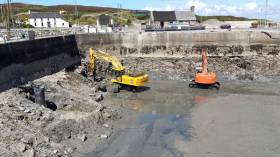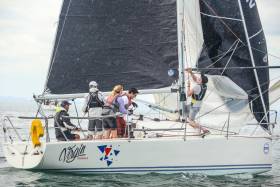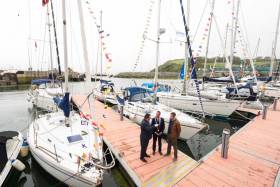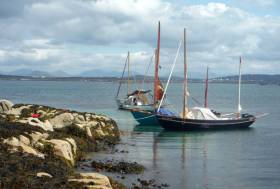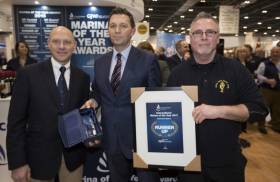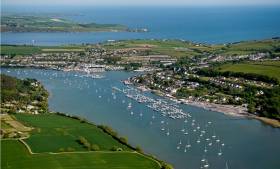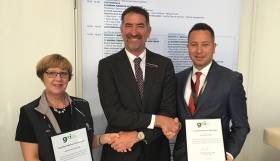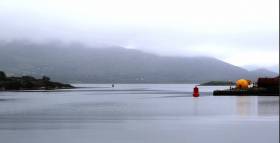Displaying items by tag: Marina
Marina Pontoon Works Underway at Cape Clear Island
Marina pontoon installation work is well underway at Cape Clear Island's North Harbour where pontoons to the value of €200,000 have been procured for the West Cork island harbour.
Under the 2017 fishery harbour and coastal infrastructure capital programme, Junior Minister Andrew Doyle told the Dail Harbour's debate in June he had allocated €720,000 for maintenance and development works at the Island's North Harbour.
'The 2017 programme provides €200,000 for pontoons at Cape Clear and €250,000 for the design, preparation of contract documents and planning for additional repair work to Duffy's Pier' he said.
Read more on the works in our June report here.
140–boats are expected off the coast of County Wicklow for the two–race 'Taste of Greystones Trophy' later this month.
Greystones Sailing Club (GSC) will be keeping its fingers crossed for better winds than two years ago when the 2017 edition sets sail this August 26th. In 2015, the event was becalmed and rescheduled but its been the only blot for the newest east coast regatta that has been a runaway–success for the traditional dinghy club. GSC has also been embracing cruiser–racing since the new marina opened in the harbour, four years ago.
Started in 2013, by Greystones Sailing Club, the new cruiser event has focused on the 'social experience Greystones village offers', according to club Commodore Daragh Cafferkey, a regular ISORA sailor.
Clubs from Howth, Clontarf, Poolbeg, Dublin Bay, Bray, Wicklow, Arkow and Courtown – and perhaps some from as far afield as Wales too – are expected in Wicklow for the regatta sponsored by marina operator BJ Marine.
Bantry Bay Port Company officially opened the new Bantry Harbour Marina yesterday (Friday, 11th August 2017). Over 40 boats visited the new marina which was officially unveiled by Bantry’s own footballing legend, Graham Canty along with Bantry Bay Port Company Chairman, John Mullins.
To celebrate the opening, Bantry Regatta and BBQ Festival is taking place all weekend (11th - 13th August) with lots of fun family events, both on and off the water happening on the marina and throughout Bantry town.
The opening of the new marina is part of the overall Bantry Inner Harbour Development which marks the start of the regenerating of the Inner Harbour Development scheme developed by the Bantry Bay Harbour Commissioners in 2012.
Speaking at the opening, Bantry Bay Port Company and Port of Cork Chairman John Mullins said “We are delighted that the new Bantry Harbour Marina is now open for local and visiting boats to enjoy. This new sheltered harbour facility will be of great benefit to both commercial and leisure users bringing increased activity in Bantry Harbour and Town and we would like to acknowledge the cooperation and patience of all local harbour users shown throughout the construction period.”
He continued, “We are pleased to have worked closely with the Bantry Development & Tourism Association and the Bantry Business Association to host the inaugural Bantry Regatta & BBQ Festival which is sure to be a fantastic weekend for all.”
Brendan Keating CEO Bantry Bay Port Company and Port of Cork said “I’d like to pay particular thanks to BAM Construction and Malachy Walsh Consulting Engineers and our own port teams in Bantry and in Cork.”
He continued, “The Inner Harbour Development will provide improved access and facilities on the town pier, will support existing businesses and will promote and increase commercial activity in Bantry Harbour and Town.”
Bantry Harbour Marina will provide 40 short-stay berths for the marine leisure sector in close proximity to Bantry Town which will provide a critical kick-start for the marine leisure industry, with the aim to attract more marine tourism to the area.
Galway Bay Can Make it Happen While Other Places Wait for Development to Come to Them
Irish sailors don’t need their attention mesmerized by the horses and people clattering around the Galway Races Week to be well aware that in sailing matters too, it’s not a question of whether or not the West’s awake writes W M Nixon. On the contrary, you’d wonder do the hyper-energetic sailors around Galway Bay ever sleep as they implement one bright new idea after another, for these days the coastal facilities are being developed at a pace which few other popular sailing areas can match.
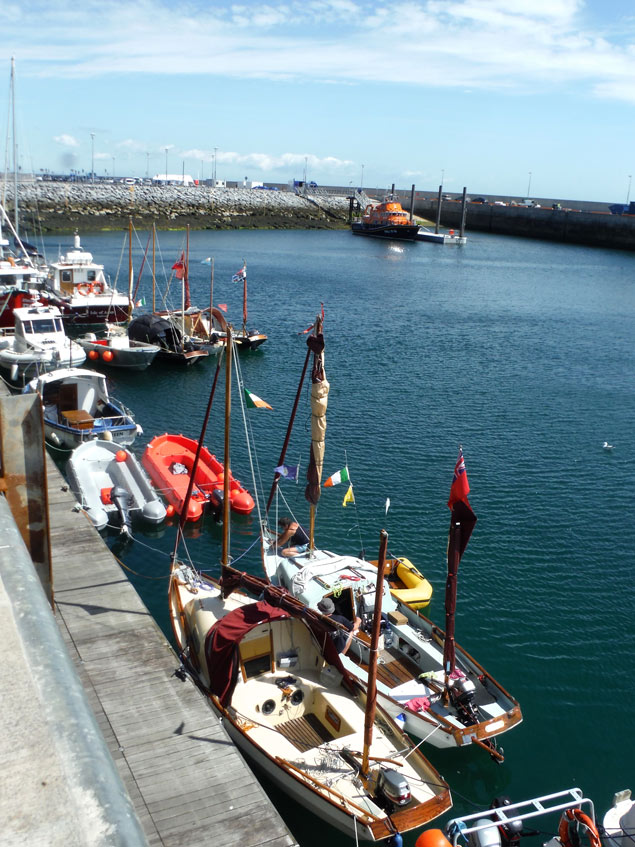 Just a week after the WIORA fleet had been in town, the Drascombe flotilla were one of the first cruising groups to use the new pontoons at Kilronan on Inishmore. Photo: Jack O’Keeffe
Just a week after the WIORA fleet had been in town, the Drascombe flotilla were one of the first cruising groups to use the new pontoons at Kilronan on Inishmore. Photo: Jack O’Keeffe
Until recently in southeast Connmemara, Rosamhil (or Rossaveal as the East Coast might know it) was mainly thought of as a busy fishing port and the ferry port for the Aran Islands. But a while back, it acquired a 34-berth marina which has proven so popular that in October this year the Harbour Master, Captain John Donnelly, will be overseeing the official opening of a brand new facility, a fully-serviced 160-berth marina which will be attractive both to locals and those from further afield and abroad who are taken with the notion of berthing their boats on the threshold of some of the most enchanting sailing waters in the world.
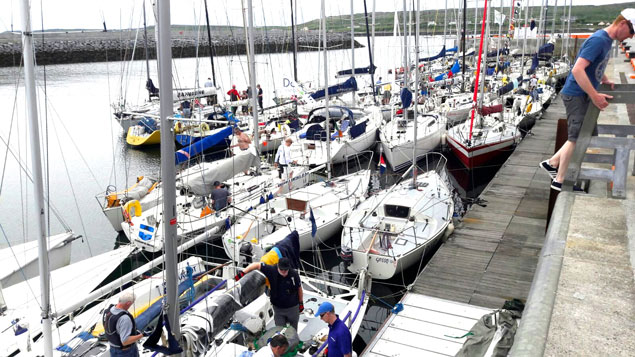 Packing them in. A week before the Drascombes arrived, the WIORA fleet had landed in on Kilronan big time
Packing them in. A week before the Drascombes arrived, the WIORA fleet had landed in on Kilronan big time
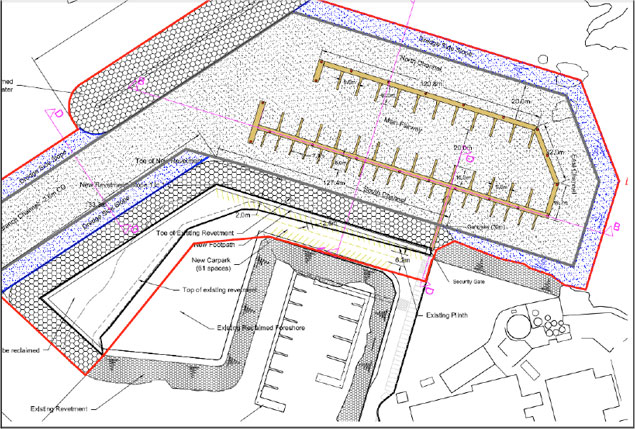 Meanwhile across on the mainland, the new marina at Rossaveal is nearing completion
Meanwhile across on the mainland, the new marina at Rossaveal is nearing completion
But while this is now almost completely in place, towards the head of Galway Bay the port of Galway itself is contemplating another expansion with marina facilities, while across the bay at Renville, as we’ve mentioned on Afloat.ie, Galway Bay SC has recently made a very clever job of improving its clubhouse, and it is surely only a matter of time before developments in waterfront berthing take place there too.
But the extra-special breakthrough which has best expressed the Spirit of the West has been the installation of the long L-shaped pontoon in the much-extended Kilronan Harbour on Inishmore, the largest of the Aran Islands. This was planned to be done in time for the mighty successful West of Ireland Offshore Racing Association Championship just over three weeks ago, and the new setup accommodated the 44-strong fleet in such style that a casual observer might gave though that this was all a permanent new fixture.
Certainly the way that the WIORA sailors partied for their après sailing there and in downtown Kilronan would if anything have reinforced such a view. Yet in theory those pontoons are just a temporary arrangement. And they were put there in a shared voluntary effort which would put some of our more hidebound maritime communities to shame for its sheer enthusiasm and energy.
Those who were promoting the Kilronan Berthing Project - not least WIORA Championship Organiser Cormac Mac Donncha – argued that with all of the new berthing capacity in the city and in Rossaveal, those boat owners would need somewhere to visit and berth safely. This is where the pontoon in Kilronan comes in, with the benefits going well beyond recreational sailing. The users will include the small ‘pot haulers’ owned by the local fishermen, commercial angling boats, commercial charter sailing yachts, visiting motor vessels, and yachts.
Galway County Council were very supportive of the project. Patrick McDonagh, Kilronan Harbour Master, provided supervision and advice throughout. Ciarán Wynne, Harbours Engineer, Galway Co Co, provided the promoters with the various permissions to go ahead with the project. The pontoon was installed by the voluntary effort of local business men and volunteers, in a heartening community spirit.
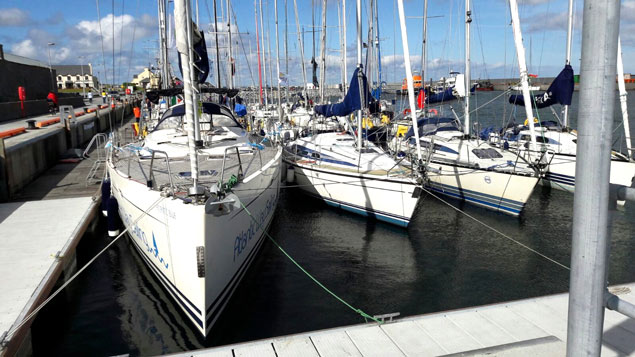 As soon as it was very competently installed, the new Kilronan pontoon had a fleet in port to show it at its best.
As soon as it was very competently installed, the new Kilronan pontoon had a fleet in port to show it at its best.
The pontoons themselves were supplied on loan by Inland & Coastal Marinas, based in Banagher on the Shannon. Iggy Madden Transport of Galway, provided the transport without charge. Galway Harbour Board supported the storage and crane operations at Galway Docks and Lasta Mara Teo transported the cargo to the Islands and dropped 16 mooring blocks. LM Keating installed the pier beams, and OceanCrest Marine supplied the special pontoon to H-Beam bracketry. ThermoKing, the Beatty family and Club Seoltóireacht Árainn provided the skilled crew to install the pontoons and make them safe.
Inland & Coastal has extended the loan of the pontoons so that the local committee can attempt to put a plan together to purchase and upgrade them to form a permanent facility. A very significant proportion of the project’s cost lies in the selection, transportation and installation of the pier beams and pontoons. Galway Co Co are working with the committee to try to find a funding solution to upgrade the existing ‘marina’. It has been recognised that, if the pontoons are returned to Inland & Coastal at this stage, then a large percentage of the cost will need to be duplicated in order to reinstate the marina at a later stage.
 A touch of the Med in Kilronan. WIORA even had St Pat’s Brass Band (left) to welcome them in.
A touch of the Med in Kilronan. WIORA even had St Pat’s Brass Band (left) to welcome them in.
So efforts to seek funding are currently underway. You just can’t see it not happening, and a longer term objective might be the installation of an access bridge, as the 5 metre tidal range can make that quay wall seem very high. Once the sportsmen and revellers of WIORA had gone on their way, there was ample and much-valued space for local boats of all type, and then a week later the Drascombe Association of Ireland arrived in a fleet from Roundstone in the midst of their week-long Galway Bay Cruise-in-Company. Even though a Drascombe can be hauled up a beach if need be, every last one of them was delighted with the convenience and comfort which the new pontoon provided.
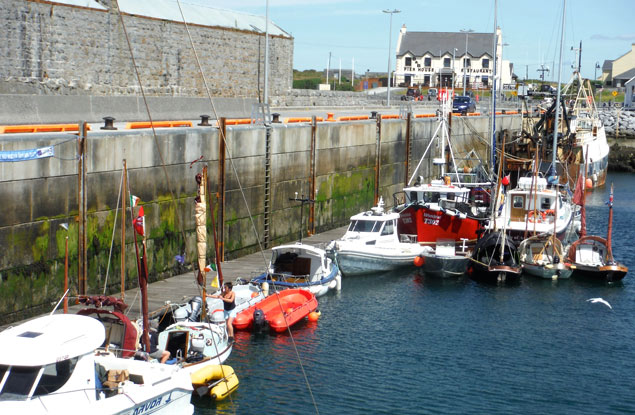 Drascombes and other boats at Kilronan pontoon – as convenient as possible for the pub. Photo: Jack O’Keeffe
Drascombes and other boats at Kilronan pontoon – as convenient as possible for the pub. Photo: Jack O’Keeffe
Seen from a go-anywhere Drascombe, Galway Bay becomes the cruising paradise its advocates have always insisted is there, waiting to be discovered. The Drascombes, co-ordinated by Jack OKeeffe of Cork and Brian Park of Limerick, had mustered at Kilkieran, and then cruised along the coast to Finnish Island before heading for Roundstone. Mac Dara’s island came up on the programme, and then there was an open water passage out to Kilronan and the luxury of a secure marina berth at the end of it.
They’d hope to cruise among the Aran Islands in detail, but the weather was going to pot and they decided to get on with the next stage of their programme. So as pre-arranged, the open boats headed back to Kilkieran and the cabin Drascombe boats made a passage across to Ballyvaughan in the foothills of The Burren in County Clare, which left them well-placed for detailed exploration to fresh places such as Leenane’s renowned seafood bar at New Quay, followed by the winding waterways of Bell Harbour.
Kinvara was a natural stopover port, and they finally brought it all to a successful conclusion back at Galway Bay SC at Renville, firmly convinced of the unique attractions of the greater Galway Bay area as a cruising ground, and one hundred per cent supportive of the notion that the new pontoons at Kilronan should be a permanent feature.
Lough Derg Marina at Kylenashee On The Market
A Lough Derg marina at Kylenashee, near Portumna in County Galway is on the market for the first time with vacant possession.
The lake front property, that is suitable for a variety of uses, has been in use in recent years as a marina with berthing for 25 boats.
The property is advertised on Afloat's marine market and has 'substantial lake frontage' on approximately seven acres.
Read the full announcement here
Green Light for Youghal Pontoon As Funding Approved
Cork East Fine Gael TD and Minister of State at the Department of Justice, David Stanton has welcomed the funding announcement of €112,500 for the development of a pontoon and gangway in Youghal.
News of the proposal broke on Afloat.ie last March here.
“The announcement is great news for Youghal and will allow for the supply and installation of a pontoon and gangway in Youghal Harbour. Cork County Council has done a huge amount of work to get this project underway and has already secured the necessary planning permission and foreshore licence to allow the development to proceed”, said Minister Stanton.
“Last year eight visitor buoys were put in place in Youghal harbour and these have been very successful in attracting marine leisure tourism to the town. I am confident that the pontoon will build on the success of these buoys and greatly enhance Youghal’s marine tourism offering and lead to an increase in visitors to this historic town.
“This funding is another substantial investment in Youghal’s tourism product. In addition to the development of Youghal’s heritage trail which includes the Raleigh Quarter, the medieval town walls, St Mary’s Collegiate Church and gardens next door, Youghal Clock Gate was opened to the public at the end of last year and is proving very popular. The refurbished boardwalk is also widely used by locals and visitors alike.
“Youghal wastewater treatment plant is also due to be completed by the end of this year and this project along with the other wastewater infrastructure works will allow for further development in the town into the future.
“I am very pleased that Youghal pontoon project has been awarded funding under the Local Authority Harbour programme. This scheme provides for 75% funding by the Department of Marine with the balance being supplied by Cork County Council. I would hope that, if this project is as successful as expected in attracting visitors to the town, this project would lead to further investment in marine leisure facilities in Youghal in the not too distant future.
Royal Cork Yacht Club Celebrate Top Marina Award at London Boat Show
The Royal Cork Yacht Club in Cork Harbour achieved second place in a strong international field at the International Marina of the Year Awards and, as previously reported by Afloat.ie, were just pipped to the post by the Karpaz Gate Marina, located in northern Cyprus.
Gavin Deane, General Manager at the Royal Cork Yacht Club, said: “We are delighted to receive this significant award from TYHA. This is as a result of the hard work of the Executive Committee and Club Staff since the Royal Cork attained the Five Gold Anchor Status in late 2011. The award means so much to everyone at the Club as it is voted for by both our berth holders and visiting boats”.
For more on this story click here
Royal Cork Yacht Club recently became the first Yacht Club marina in the country to receive the Fáilte Ireland Welcome Standard accreditation for accommodation on its marinas and facilities. “The Club are delighted to have received this accreditation from Fáilte Ireland and we hope the ‘Welcome Standard’ will help attract even more visiting boats from around Ireland, the UK and further afield to visit Cork Harbour. There is plenty to see and do around the harbour as in recent years there has been a huge increase in infrastructural development, with Camden Fort Meagher and Spike Island being two great examples” commented General Manager, Gavin Deane.
Fáilte Ireland's (FI) role is to support the tourism industry and work to sustain Ireland as a high-quality and competitive tourism destination.
With the Quality Assured banner FI have developed new standards to allow for greater innovation, individuality and authenticity in their approved tourist accommodation businesses.
The standards recognise accommodation businesses of all types and styles that are committed to tourism and to maintaining high standards and practices throughout their business. It is targeted at atypical tourist accommodation businesses who do not fit in the existing approval frameworks such as glamping, pods, shepherd huts, yurts, lighthouses and marinas.
The standards identify the strengths of businesses, without taking away any of the character and style of the individual property.
First Ever Female Certified Marina Professional Awarded
The ICOMIA World Marinas Conference in Amsterdam (17-19 November 2016) provided the ideal backdrop for the presentation of the latest two Global Marina Institute (GMI) certificates.
Michelle Hitchcock, Head of Business Development at MDL Marinas Ltd, was awarded the Certified Marina Professional (CMP) certificate. Michelle is the first woman in the world to be accredited as a CMP, since its inception in 2012.
Designed to recognise the skills and experience of those working in the marina sector, but not directly managing marinas, Michelle is the perfect candidate to receive this accolade. She has worked at MDL Marinas Ltd since 1999 in a variety of roles but is now Head of Business Development.
Working at one of Europe’s leading marina groups, she is responsible for the company’s training development and delivery, the monitoring of customer service and quality and overseeing all operational aspects of business systems throughout the group’s 100+ marinas located across the UK, France, Italy and Spain.
Upon receiving her certification, Micelle Hitchcock commented: “I am honoured and proud to be awarded my CMP accreditation by the GMI. This is a major highlight of my career, made more special as the presentation was in front of an audience of my peers at the ICOMIA World Marinas Conference.”
Can Akaltan was also presented with his Certified Marina Manager (CMM) certificate during the Conference. Can is General Manager at Cesme Marina in Izmir, Turkey. Building on his successful career as a yacht captain, he joined Cesme Marina as the Marina Manager and has since been promoted to the position of General Manager.
Can Akaltan also remarked: “I feel privileged to be awarded the only internationally recognised certificate in the marina industry for marina professionals. It is also a great pleasure to become part of a very special group of industry pioneers.”
John Hogan, Chairman of the GMI, added: “It is good to have our first female CMP, particularly as she is from Europe, to add to those marina professionals already certified in Australia and Asia. I am hopeful that Michelle will pave the way for others who work in the industry to look to CMP as a way of developing and recognising their talents. It is also good to see another CMM recognised in Turkey.”
Today the GMI has awarded 130 active CMMs and CMPs across the globe and looks to continue this growth into 2017.
British Marine contributes to this by running a series of GMI marina management courses in locations across the UK and Europe.
New Navigation Buoy Installed at Lawrence Cove, Bantry
New navigation buoys have been installed at the entrance to Lawrence Cove, near the village of Rerrin on Bere Island, one of the most sheltered harbours in Bantry Bay on Ireland's South–West coast.
A marina at Lawrence Cove is located opposite the fishing port of Castletownberehaven at the North side of Bere Island. Lawrence Cove Marina is the only fully serviced marina between Kinsale and Cahirciveen making it an important stop–over location for cruising yachts.



























